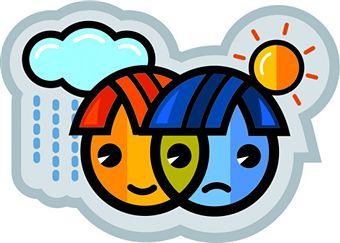In my previous two entries, I discussed the overview of the other disorders that are to be considered as part of neurodiversity. These are the following:
Schizoaffective Disorder[1]
Parkinson’s Disease[1]
Circadian Rhythm Disorder[1]
Developmental Speech Disorder[1]
Dysnomia[1]
Bipolar Disorder[1]
Depression[2]
Obsessive Compulsive Disorder[1]
The first five disorders are already discussed. Here, the remaining three disorders are described below:
BIPOLAR DISORDER

Image courtesy of bipolar-symptoms.org
Bipolar disorder is a mental illness marked by extreme shifts in mood ranging from a manic to a depressive state. Bipolar disorder is also called bipolar disease or manic depression.[3] Here, a person affected experiences extreme joy/aggressiveness (mania) at one moment and then extreme sadness (depression) the following moment. Sometimes, mania occurs for 1 week followed by depression for 2 weeks and continues in a cycle. Bipolar disorder symptoms can result in damaged relationships, poor job or school performance, and even suicide.[4]
Nothing is known about the real cause of bipolar disorder, but there are factors that may contribute to it. Bipolar disorder tends to run in families. Some research has suggested that people with certain genes are more likely to develop bipolar disorder than others.[4] Genetic influences are believed to account for 60–80% of the risk of developing the disorder indicating a strong hereditary component.
[5][6] Abnormalities in the structure and/or function of certain brain circuits could underlie bipolar.[5] Abnormal modulation between ventral prefrontal and limbic regions, especially the amygdala, are likely contribute to poor emotional regulation and mood symptoms.[5][7] Life events could also trigger bipolar disorder.
The main symptom of bipolar disorder is mania,[8] which is a distinct period of at least one week of elevated or irritable mood, which can take the form of euphoria, and exhibit three or more of the following behaviors (four if irritable): speak in a rapid, uninterruptible manner, are easily distracted, have racing thoughts, display an increase in goal-oriented activities or feel agitated, or exhibit behaviors characterized as impulsive or high-risk such as hypersexuality or excessive money spending.[5][8] There is also a milder version of mania, called hypomania[9], which is the milder version of mania. Here, individuals appear energetic, excitable, and may be highly productive.[9]
A bipolar disorder diagnosis is made only by taking careful note of symptoms, including their severity, length, and frequency.[10] At first, bipolar is mistaken as major depression (or unipolar) as it has symptoms of depression. A full diagnosis is made when family, peers, and colleagues, and even the client herself reports alternate symptoms of mania and depression.
Management includes mood-stabilizing drug and psychotherapy.[11] Medications include lithium, where it controls acute manic episodes and preventing relapses as same as bipolar depression.[5][12] Lithium reduces the risk of suicide, self-harm, and death in people with bipolar disorder.[5][13] Sodium valproate, lamotrigine, and topiramate also are used for bipolar disorder.[5]
Psychological treatment such as talking therapy, can help you deal with depression, and provides advice about how to improve your relationships.[14] It also helps the client become aware of her triggers and learn to recognoze them.
With compliance, a person with bipolar disorder can live a full life.
How can bipolar disorder be part of neurodiversity?
According to Thomas Armstrong, people with bipolar disorder can be appreciated with their art creativity.[15] I agree with him though.
A theory was made about bipolar disorder that it may actually have been a form of hibernation. Here, the brains of our northern ancestors devised a way to oscillate their moods between manic and depressive to align the former with light, warm seasons and the latter with the cold darkness of winter.[16] It’s like what animals do. During summertime, they are manic so that they can hunt a lot of food and make babies. During winter, they shut down and go to sleep and care for their babies.
DEPRESSION

Image courtesy of wikipedia.org
Vincent van Gogh’s 1890 painting, Sorrowing old man (‘At Eternity’s Gate’)
Depression, also known as major depression, clinical depression or major depressive disorder is a medical illness that causes a constant feeling of sadness and lack of interest. Depression affects how the person feels, behaves and thinks.[17] Normally, we do experience sadness in our daily lives brought about by rejection, failure, etc., but for the depressed, they experience chronic sadness for more than 2 weeks.
Depression has types[17]:
Major depressive disorder – the typical depression. Prolonged sadness plus inability to function in daily life
Dysthymia – the milder version depression
Psychotic depression – depression plus symptoms of psychosis (hallucinations, delusioms)
Postpartum depression – depression after giving birth
Seasonal affective disorder – depression develops only in winter months
Nothing is known about the exact cause of depression. Genes may play a role. One study done by a team from Cross Disorders Group of the Psychiatric Genomic Consortium stated that depression shares a genetic variant along with other disorders (ADHD, schizophrenia, and the like).[17] People with depression have less brain volume compared to non-depressed.[17] Low levels of neurotransmitters (brain hormones) serotonin, norepinephrine, and dopamine contribute to the development of depression.[18] Depression arises when low serotonin levels promote low levels of norepinephrine.[18][19]
Symptoms include[20]:
– Feelings of sadness, emptiness or unhappiness
– Angry outbursts, irritability or frustration, even over small matters
– Loss of interest or pleasure in normal activities
– Sleep disturbances
– Tiredness and lack of energy
– Changes in appetite
– Feelings of worthlessness or guilt
– Trouble thinking, concentrating, making decisions and remembering things
– Frequent thoughts of death, suicidal thoughts, suicide attempts or suicide
– Unexplained physical problems, such as back pain or headaches
A depressed person is usually referred to a psychiatrist for diagnosis and treatment. For treatment, a combination of psychotherapy (cognitive-behavioral therapy) and medications (selective serotonin reuptake inhibitor (SSRI) and serotonin norepinephrine reuptake inhibitor (SNRI)) are used.[21] Prognosis is usually good with compliance.
Depression as part of neurodiversity:
A hypothesis was made by psychiatrist Andy Thompson and evolutionary psychologist Paul Andrews, which was called the ‘Analytic-Rumination Hypothesis.’ Here, depression is an adaptation that causes the affected individual to concentrate his or her attention and focus on a complex problem in order to analyze and solve it. Depression induces rumination where depressed individuals have been shown to ruminate, reflecting on the reasons for their current problems. In turn, they plan to have long-term solutions to ther problems.[22][23][24]
Depression is a common condition across all people regardless of race, gender, or occupation. For the complete list, see the link: http://en.m.wikipedia.org/wiki/List_of_people_with_major_depressive_disorder
OBSESSIVE-COMPULSIVE DISORDER

Image courtesy of emedicalguild.org
Obsessive–compulsive disorder (OCD) is an anxiety disorder characterized by intrusive thoughts that produce uneasiness, apprehension, fear or worry (obsessions), repetitive behaviors aimed at reducing the associated anxiety (compulsions), or a combination of such obsessions and compulsions.[25]
Symptoms of the disorder include excessive washing or cleaning, repeated checking, extreme hoarding, preoccupation with sexual, violent or religious thoughts, relationship-related obsessions, aversion to particular numbers and nervous rituals such as opening and closing a door a certain number of times before entering or leaving a room.[25]

Image courtesy of recovery.org
Do you always feel the need to clean the room with lots of soap even if it’s ultra tidy? If yes, then you have OCD.
Of the symptoms, the most famous is frequent handwashing, constantly cleaning the room, always double checking padlocks, and the like.
The exact cause is unknown. Biology and environment may contribute to the development of OCD. The disorder runs in families.[26] Scientists think that OCD arises from problems in the pathways of the brain that link areas dealing with judgment and planning with another area that filters messages involving body movements.[26]
Specific symptoms include the following[26]:
Common obsessions include:
Fear of dirt or contamination by germs
Fear of causing harm to another
Fear of making a mistake
Fear of being embarrassed or behaving in a socially unacceptable manner
Fear of thinking evil or sinful thoughts
Need for order, symmetry, or exactness
Excessive doubt and the need for constant reassurance
Common compulsions include:
Repeatedly bathing, showering, or washing hands
Refusing to shake hands or touch doorknobs
Repeatedly checking things, such as locks or stoves
Constant counting, mentally or aloud, while performing routine tasks
Constantly arranging things in a certain way
Eating foods in a specific order
Being stuck on words, images or thoughts, usually disturbing, that won’t go away and can interfere with sleep
Repeating specific words, phrases, or prayers
Needing to perform tasks a certain number of times
Collecting or hoarding items with no apparent value
Diagnosis of OCD involves the referral to a psychiatrist. The symptoms must be debilitating enough to interfere with daily living.
OCD is generally treated with psychotherapy, medication, or both.[27] Psychotherapy for OCD is cognitive behavior therapy (CBT) where it teaches a person different ways of thinking, behaving, and reacting to situations that help him or her feel less anxious or fearful without having obsessive thoughts or acting compulsively. Exposure and response prevention is especially helpful in reducing compulsive behaviors in OCD.[27]
The most commonly prescribed medications for OCD are anti-anxiety medications and antidepressants. Anti-anxiety medications are powerful and there are different types.[27]
OCD is a long-term (chronic) illness with periods of severe symptoms followed by times of improvement. A completely symptom-free period is unusual. Most people improve with treatment.[28]
Obsessive-Compulsive Disorder in Neurodiversity
Hmmm… I really don’t know if OCD should be included in neurodiversity. It can be, because of its evolutionary advantage of becoming cautious in your surroundings. OCD also is present in many neurodiverse conditions. But so far, may be it’s more of an anxiety disorder as OCD is quite common as well in the general population.
My overall verdict about whether these psychological conditions shall be included in neurodiversity will be followed up in my next blog.
References:
1. en.wikipedia.org/wiki/Neurodiversity
2. http://www.thenewatlantis.com/publications/mental-disorder-or-neurodiversity
3. http://www.healthline.com/health/bipolar-disorder
4. http://www.nimh.nih.gov/health/topics/bipolar-disorder/index.shtml
5. http://en.m.wikipedia.org/wiki/Bipolar_disorder
6. Kerner B (February 2014). “Genetics of bipolar disorder”. Appl Clin Genet 7: 33–42. doi:10.2147/tacg.s39297. PMC 3966627. PMID 24683306.
7. Strakowski SM, Adler CM, Almeida J, Altshuler LL, Blumberg HP, Chang KD, DelBello MP, Frangou S, McIntosh A, Phillips ML, Sussman JE, Townsend JD (2012). “The functional neuroanatomy of bipolar disorder: A consensus model”. Bipolar Disorders 14 (4): 313–325. doi:10.1111/j.1399-5618.2012.01022.x. PMID 22631617.
8. Barnett JH, Smoller JW (2009). “The genetics of bipolar disorder”. Neuroscience 164 (1): 331–43. doi:10.1016/j.neuroscience.2009.03.080. PMC 3637882. PMID 19358880.
9. Beentjes TA, Goossens PJ, Poslawsky IE (October 2012). “Caregiver burden in bipolar hypomania and mania: a systematic review”. Perspect Psychiatr Care 48 (4): 187–97. doi:10.1111/j.1744-6163.2012.00328.x. PMID 23005586.
10. http://www.webmd.com/bipolar-disorder/guide/bipolar-disorder-diagnosis-chap
11. http://www.webmd.com/bipolar-disorder/guide/bipolar-disorder-treatment-care
12. Brown KM, Tracy DK (June 2013). “Lithium: the pharmacodynamic actions of the amazing ion”. Ther Adv Psychopharmacol 3 (3): 163–76. doi:10.1177/2045125312471963. PMC 3805456. PMID 24167688.
13. Cipriani A, Hawton K, Stockton S, Geddes JR (2013). “Lithium in the prevention of suicide in mood disorders: updated systematic review and meta-analysis”. BMJ 346: f3646. doi:10.1136/bmj.f3646. PMID 23814104.
14. http://www.nhs.uk/Conditions/Bipolar-disorder/Pages/Treatment.aspx
15. http://www.institute4learning.com/neurodiversity.php
16. http://www.cracked.com/article_20905_5-brain-disorders-that-started-as-evolutionary-advantages.html
17. http://www.medicalnewstoday.com/articles/8933.php
18. http://en.m.wikipedia.org/wiki/Major_depressive_disorder
19. Shah N, Eisner T, Farrell M, Raeder C (July–August 1999). “An overview of SSRIs for the treatment of depression” (PDF). Journal of the Pharmacy Society of Wisconsin. Retrieved 10 November 2008.
20. http://www.mayoclinic.org/diseases-conditions/depression/basics/symptoms/con-20032977
21. http://www.adaa.org/understanding-anxiety/depression/treatment
22. http://www.nytimes.com/2010/02/28/magazine/28depression-t.html?pagewanted=all&_r=0
23. http://en.m.wikipedia.org/wiki/Evolutionary_approaches_to_depression#Analytical_rumination_hypothesis
24. Andrews, P.W.; Thompson, J.A. (2009). “The bright side of being blue: depression as an adaptation for analyzing complex problems”. Psychological Review 116 (3): 620–654. doi:10.1037/a0016242. PMC 2734449. PMID 19618990.
25. http://en.m.wikipedia.org/wiki/Obsessive%E2%80%93compulsive_disorder
26. http://www.webmd.com/anxiety-panic/guide/obsessive-compulsive-disorder
27. http://www.nimh.nih.gov/health/topics/obsessive-compulsive-disorder-ocd/index.shtml
28. http://www.nlm.nih.gov/medlineplus/ency/article/000929.htm
Posted from WordPress for Android





